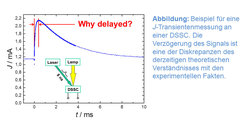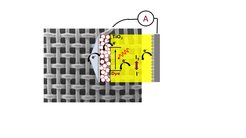Dye-Sensitized Solar Cells

For regenerative energy sources, not only high efficiencies but also economical facts are important. Therefore, the well-developed high-efficiency solar cells are not competitive to traditional energy sources without financial support.
The development of dye-sensitized solar cells (DSSCs) represents a promising alternative to conventional Si-solar cells due to their good cost-to-performance-ratio. However, the efficiencies and lifetime are lower than Si solar cells up to now. In addition, the DSSCs could be an answer on the ERoEI problem of the conventional photovoltaics (invested energy return problem).
In our group we focus on fundamental aspects of charge transfer mechanisms in DSSCs which we consider as not fully understood (1). Furthermore, we investigate effects and processes that are influencing the DSSCs lifetime.

Light-weight dye-sensitized solar cells on stainless steel meshes of the types 304, 316Ti, 904L, and 20Cb-3 were successfully fabricated.(2) Surprizingly, all fabricated solar cells have shown a voltage shift of about 0.2 V in comparison to standard DSSCs and a hysteresis in the J-V characteristics, which strongly depends on the scan rate. A large capacitance of 171 µF/cm2 was found to describe this effect. The observed capacitive section of the hysteresis is ascribed to charge storage on the TiO2@stainles steel electrodes. The stainless steel skin behaves like an n-semiconductor as required for the standard DSSC action, but it creates a slight barrier between the electrode interior and the TiO2. A general lesson of this behavior is that the characteristic voltages of DSSCs are not only a result of the properties of the outer anodic n-semiconductor and the electrolytic redox-couple as stated in the standard mechanistic explanations.
(1) F. Marlow, A. Hullermann, L. Messmer: Is the Charge Transport in Dye-sensitized Solar Cells Really Understood? Adv. Mater. 27 (2015) 2447–2452
DOI:10.1002/adma.201404883
(2) Sabine Josten, Tillmann Koehler, Frank Marlow: Dye-sensitized solar cells on stainless steel substrates. Solar Energy 247, (2022) 346-354. https://www.sciencedirect.com/science/article/pii/S0038092X22007691

